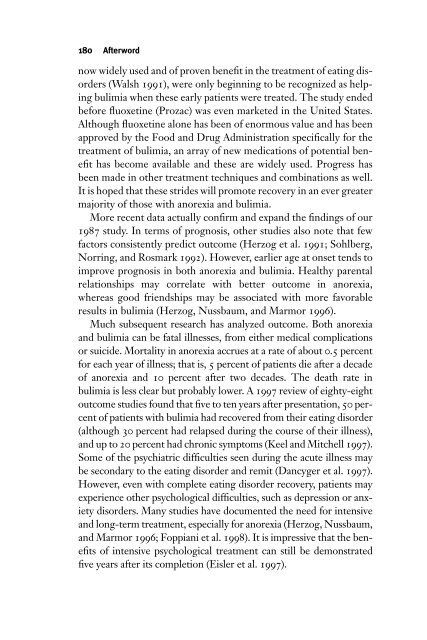Eating Disorders - fieldi
Eating Disorders - fieldi
Eating Disorders - fieldi
You also want an ePaper? Increase the reach of your titles
YUMPU automatically turns print PDFs into web optimized ePapers that Google loves.
180 Afterword<br />
now widely used and of proven benefit in the treatment of eating disorders<br />
(Walsh 1991), were only beginning to be recognized as helping<br />
bulimia when these early patients were treated. The study ended<br />
before fluoxetine (Prozac) was even marketed in the United States.<br />
Although fluoxetine alone has been of enormous value and has been<br />
approved by the Food and Drug Administration specifically for the<br />
treatment of bulimia, an array of new medications of potential benefit<br />
has become available and these are widely used. Progress has<br />
been made in other treatment techniques and combinations as well.<br />
It is hoped that these strides will promote recovery in an ever greater<br />
majority of those with anorexia and bulimia.<br />
More recent data actually confirm and expand the findings of our<br />
1987 study. In terms of prognosis, other studies also note that few<br />
factors consistently predict outcome (Herzog et al. 1991; Sohlberg,<br />
Norring, and Rosmark 1992). However, earlier age at onset tends to<br />
improve prognosis in both anorexia and bulimia. Healthy parental<br />
relationships may correlate with better outcome in anorexia,<br />
whereas good friendships may be associated with more favorable<br />
results in bulimia (Herzog, Nussbaum, and Marmor 1996).<br />
Much subsequent research has analyzed outcome. Both anorexia<br />
and bulimia can be fatal illnesses, from either medical complications<br />
or suicide. Mortality in anorexia accrues at a rate of about 0.5 percent<br />
for each year of illness; that is, 5 percent of patients die after a decade<br />
of anorexia and 10 percent after two decades. The death rate in<br />
bulimia is less clear but probably lower. A 1997 review of eighty-eight<br />
outcome studies found that five to ten years after presentation, 50 percent<br />
of patients with bulimia had recovered from their eating disorder<br />
(although 30 percent had relapsed during the course of their illness),<br />
and up to 20 percent had chronic symptoms (Keel and Mitchell 1997).<br />
Some of the psychiatric difficulties seen during the acute illness may<br />
be secondary to the eating disorder and remit (Dancyger et al. 1997).<br />
However, even with complete eating disorder recovery, patients may<br />
experience other psychological difficulties, such as depression or anxiety<br />
disorders. Many studies have documented the need for intensive<br />
and long-term treatment, especially for anorexia (Herzog, Nussbaum,<br />
and Marmor 1996; Foppiani et al. 1998). It is impressive that the benefits<br />
of intensive psychological treatment can still be demonstrated<br />
five years after its completion (Eisler et al. 1997).









